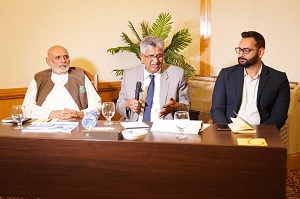China’s climate change solutions more feasible for Pakistan” Report

Karachi: China’s solutions to climate change are more feasible for countries such as Pakistan, a Report on climate change published by KASB Securities Thursday afternoon on a climate change seminar ahead of the upcoming COP27 said.
“We think China’s solutions to climate change are more feasible for countries such as Pakistan. China’s status as a developing nation allows it to relate to the realities of other developing countries and formulate a more suitable and effective plan for tackling climate change,” reads the Report unveiled at the seminar.
According to another recent report, a Green Corridor will be launched jointly with China to focus on agricultural environment, food security, and green development, which is part of the two brother countries’ collaboration towards a green future.
In the power sector, the largest carbon emitting source in Pakistan, ambitious steps have been taken. The Alternative Energy Development Board (AEDB) has unveils policy for 10,000 MW solar PV energy initiative, which, according to CEO AEDB, would require US $ 6 billion investment.
Chinese companies and banks are best suited to finance these projects as they have already been working in Pakistan for various Power Projects. By 2030, Pakistan aims for an overwhelming share of renewables in its installed capacity
China is encouraging the participation of Chinese companies in Pakistan’s endeavor for green, low carbon and environment-friendly development, as has been confirmed in the Joint Statement between China and Pakistan released this week during Prime Minister Shehbaz Sharif’s state visit to China.
The Joint Statement said: “Appreciating Pakistan’s initiative to combat human-induced climate change and China’s initiative to promote green cooperation under the Belt and Road Initiative, the two sides agreed to step up cooperation in such areas as ecosystem restoration and water resource management”.
As of yesterday, the devastating floods in Pakistan has caused 1,739 deaths, 12,867 injured, and 33 million displaced, offering a most prominent example of the massive humanitarian costs the Global South is paying for the high carbon emissions of the North.
“The people of Pakistan are the victims of a grim calculus of climate injustice. Pakistan is responsible for less than 1 per cent of global greenhouse gas emissions, yet it is paying a supersized price for manmade climate change”, noted UN Secretary-general Guterres on the General Assembly.
From a historical perspective, the cumulative GHG emissions originating from the developed world have significantly outpaced developing countries. As per IEA, from 1971 to 2020, G7 accounted for 34.5% of the world’s total GHG emissions in the energy sector. The US alone takes up 20% of the world’s total, nearly 56x higher than Pakistan and is the world’s leading GHG emitter, the KASB Securities Report added.
Worse still, the economic rebound after Covid-19 led to the highest-ever level of emissions from power plants and coal consumption, pushing the CO2 emission level to an all-time high.
Since the developed nations have taken the advantage of “taking first steps on the development ladder”, the report appeals that these countries should take greater responsibility in tackling climate change.
“With 2022 already set to become one of 10 warmest years on record, there is a dire need of increased technical and financial support to combat climate change”, the Report stressed.
According to the UN Adaption Gap Report, the estimated climate adaption cost was found to be 5-10 times higher than the present public adaption finance flows. The world expects the US and EU to deliver on the $100 billion climate finance commitment to developing countries and take the lead in emissions reduction to ensure the right to development of developing countries.
In addition, fair and reasonable reduction in emission standards should be put in place. The US President Biden has set a 50-52% reduction target in carbon emissions by 2030 from levels witnessed in 2005. But as per Emission Database for Global Atmospheric Research (EDGAR), even a 50% reduction suggests the US’s per capita emissions in 2030 would be nearly 2.2x the current world average.
“Climate Justice”, therefore, is what Pakistan is making case for at COP27 to be held in Egypt from 6 to 18 this month, expecting “no sidelining of these pressing matters”.
“If Pakistan emits less than 1% that causes the warming that triggers such shocks, why is assistance cast in a ‘disaster aid’ or ‘begging bowl’ basket? It should not. Right now, there is no real basket of accessible funds for climate resilient recovery, let alone disaster assistance. Since both are triggered by climate impacts, the economic buffer for countries already in debt stress should be clearly appropriated and disbursed as climate funds that are easy to access”, Pakistani Climate Minister Sherry Rehman said recently.
The Report emphasized that the developing nations should not face undue pressure from developed nations to take drastic steps in reducing cumulative greenhouse gas (GHG) emissions.
It added: “Given the disproportionately high cumulative greenhouse gas (GHG) emissions from developed countries in history, the developing countries should not face undue pressure from developed nations to take drastic steps in reducing GHG emissions”, stressed report on climate change published by KASB Securities on a climate change seminar ahead of the upcoming COP27.”
Pakistan has been pouring efforts to tackle the tremendous challenge together with the international community.





